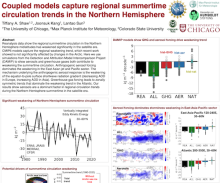Coupled models capture regional summertime circulation trends in the Northern Hemisphere
Tiffany
Shaw
The University of Chicago
Poster
Reanalysis data show the regional summertime circulation in the Northern Hemisphere midlatitudes has weakened significantly in the satellite era. CMIP6 models capture the regional weakening trend, which recent work showed is not significantly affected by changes in the Arctic. Here we use simulations from the Detection and Attribution Model Intercomparison Project (DAMIP) to show aerosols and greenhouse gases both contribute to weakening the summertime circulation. Anthropogenic aerosol forcing dominates the weakening of the East Asian jet and Pacific storminess. The mechanism underlying the anthropogenic aerosol response is the weakening of the equator-to-pole surface shortwave radiation gradient. Greenhouse gas forcing leads to zonally symmetric trends that dominate the weakening trend of Atlantic storminess. Our results show aerosols are a dominant factor in regional circulation trends during the Northern Hemisphere summertime in the satellite era.

Poster file
shaw-tiffany-confronting-poster.pdf
(3.26 MB)
